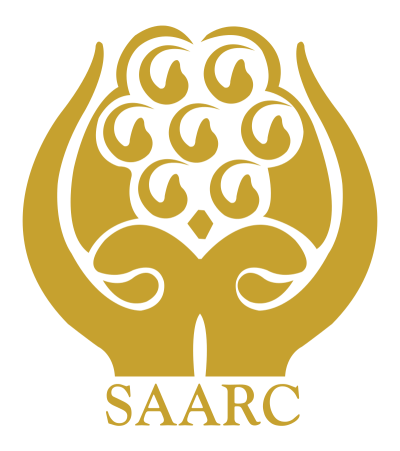Course description
The South Asian Association for Regional Co-operation (SAARC)
 It was Ziaur Rahman, President of Bangladesh, who, in 1977, addressed letters to the leaders of the six other South Asian countries calling for a trade alliance between Bangladesh, Bhutan, India, the Maldives, Nepal, Pakistan and Sri Lanka. This had long been discussed between the seven nations – in fact, in 1947 in New Delhi; in 1950 in Manila, Philippines; and in 1954 in Colombo but there had been no real progress. It took General Zia to push the agenda forward in the late ‘70s.
It was Ziaur Rahman, President of Bangladesh, who, in 1977, addressed letters to the leaders of the six other South Asian countries calling for a trade alliance between Bangladesh, Bhutan, India, the Maldives, Nepal, Pakistan and Sri Lanka. This had long been discussed between the seven nations – in fact, in 1947 in New Delhi; in 1950 in Manila, Philippines; and in 1954 in Colombo but there had been no real progress. It took General Zia to push the agenda forward in the late ‘70s.
In December that same year, Zia discussed the issue with Morarji Desai, Prime Minister of India, and King Birendra of Nepal called for an agreement between all the nations on water sharing, something which had caused many political and diplomatic rows between India, Pakistan, Nepal and Bangladesh. Yet, things still did not move forward very quickly.
 The Soviet invasion of Afghanistan in 1981 made discussions between the South Asians more urgent though, as now there was a superpower knocking at their door – and one with a huge nuclear arsenal. Zia came up with a document for a loose economic association of the original member states, which was immediately agreed by Bhutan, the Maldives, Nepal and Sri Lanka. But India and Pakistan, those two old enemies, were suspicious. India was worried that the smaller nations might unite against it on security issues. And Pakistan believed that the whole organization might be a plot by India to create economic cooperation, which would mean that Indian goods would increase the country’s already very strong advantage in trade over all the other members.
The Soviet invasion of Afghanistan in 1981 made discussions between the South Asians more urgent though, as now there was a superpower knocking at their door – and one with a huge nuclear arsenal. Zia came up with a document for a loose economic association of the original member states, which was immediately agreed by Bhutan, the Maldives, Nepal and Sri Lanka. But India and Pakistan, those two old enemies, were suspicious. India was worried that the smaller nations might unite against it on security issues. And Pakistan believed that the whole organization might be a plot by India to create economic cooperation, which would mean that Indian goods would increase the country’s already very strong advantage in trade over all the other members.
However, Zia did not give up and, by 1983, the foreign ministers of all the South Asian nations were meeting in Dhaka to finalise an implementation plan for cooperation in five areas. These were:
· Agriculture
· Rural Development
· Telecommunications
· Meteorology and
· Health and Population Activities
It was explicitly agreed that there was no role within SAARC for political bargaining or criticism of each other’s human rights records. In other words, the alliance was an economic one and only an economic one!
 There were excellent reasons why an organization like SAARC was necessary for regional development. Although the area covered only 3% of the world’s landmass, it had, in 2019, 22% of its population – but only 4.2% of the global economy. If SAARC countries could agree to increase trade between each other, they could clearly move these statistics in a positive direction. After all, a fifth of the Earth’s population needed to eat, drink, wear clothes, use building materials, and so on. There were obvious benefits for everyone. As such, all trade barriers should be removed so that no country would tax another’s exports.
There were excellent reasons why an organization like SAARC was necessary for regional development. Although the area covered only 3% of the world’s landmass, it had, in 2019, 22% of its population – but only 4.2% of the global economy. If SAARC countries could agree to increase trade between each other, they could clearly move these statistics in a positive direction. After all, a fifth of the Earth’s population needed to eat, drink, wear clothes, use building materials, and so on. There were obvious benefits for everyone. As such, all trade barriers should be removed so that no country would tax another’s exports.
However, although SAARC was established on 7th December, 1985, in Dhaka at a conference hosted by President Ershad (as Zia was assassinated in May, 1981), a Free Trade Zone was only set up between the nations in 2006, by which time Afghanistan had also joined the group. And this did not mean that there were no taxes on SAARC imports to member states. The countries only agreed to reduce these to a maximum of 20% by 2009.
It is true, of course, that by 2012 the increase in exports was considerable. In three years, they had rocketed from $207 to $355 billion. Import figures were even more impressive: they rose from $330 to $602 billion. It all sounded like very, very good news …. until compared with the Association of Southeast Asian Nations (ASEAN). ASEAN actually has a smaller total economy than SAARC, but its trade between member countries amounts to 10% of its Gross Domestic Product (GDP), whereas that figure is only 1% among SAARC nations. Tiny!
The Asian Development Bank has commented that the potential trade between SAARC members should be around $22 billion annually, but is, in fact, only $8 billion.
 But, perhaps, there are other benefits for the citizens of SAARC countries, such as free travel between countries? Sorry but no! Although a Bangladeshi can enter Nepal once a year for 14 days without a visa, no such arrangement exists with India or Pakistan, for instance, except for politicians, High Court judges, journalists and wealthy entrepreneurs as well as international athletes and the like. And these must be renewed every year!
But, perhaps, there are other benefits for the citizens of SAARC countries, such as free travel between countries? Sorry but no! Although a Bangladeshi can enter Nepal once a year for 14 days without a visa, no such arrangement exists with India or Pakistan, for instance, except for politicians, High Court judges, journalists and wealthy entrepreneurs as well as international athletes and the like. And these must be renewed every year!
All in all, SAARC has been a disappointment. But why? After all, it started out with very good intentions. The association was home-grown. There was no superpower pushing the region to form an economic union. SAARC has not been used by outside powers for their own military goals. With both the European Union and ASEAN, these were US-sponsored organizations that were designed to isolate the Communist Soviet Union and act at America’s request. However, although SAARC should be a forum for discussion between its members, not pressurized by any outside power, its trade between partner states even today is only a tiny 5%.
 It is true, of course, that SAARC still exists, even after many political disagreements between Pakistan and India, often because of the Kashmir issue. Yet, 400 million people remain in extreme poverty across the region – 30% of its total population – although rural development was one of its five most important goals at the beginning. The HDI (or Human Development Index), a report commissioned by the United Nations Development Program, which 189 ranked countries all over the world on their standards of living in 2019, based on education, life expectancy and real income, provides further evidence of SAARC’s failure to supply the needs of the truly poor. Here are the statistics:
It is true, of course, that SAARC still exists, even after many political disagreements between Pakistan and India, often because of the Kashmir issue. Yet, 400 million people remain in extreme poverty across the region – 30% of its total population – although rural development was one of its five most important goals at the beginning. The HDI (or Human Development Index), a report commissioned by the United Nations Development Program, which 189 ranked countries all over the world on their standards of living in 2019, based on education, life expectancy and real income, provides further evidence of SAARC’s failure to supply the needs of the truly poor. Here are the statistics:
Sri Lanka is ranked at 71 (because of its excellent education system and almost universal literacy) but then there is a long wait until we reach the next highest-scoring nation, the Maldives at 104. There’s another significant gap between the island nation and India at 129, Bhutan ranked at 134, Bangladesh at 135, Nepal at 147 and, finally, Pakistan at 152. If we compare these figures with the 2016 ones, Bangladesh has jumped 7 places: Sri Lanka only 2, India 1, while the Maldives has remained static and Bhutan, Nepal and Pakistan have all dropped in the rankings.
We have already said that SAARC has survived several international disputes between its members, most notably Pakistan and India. Yet, one of the main reasons why so little progress has been made is because of the size, population and economic power of India, which sometimes behaves to other member states like they were poor sisters, Cinderella figures, in actual fact. India borders every other member state, except Afghanistan, and is the nearest country to Sri Lanka and the Maldives. It has used its geographical, economic and political power to threaten the existence of the Association. For instance, in 2016, India refused to attend the summit because it was going to be held in Islamabad and there had recently been a Pakistani attack on some soldiers in Kashmir.
India and sometimes Pakistan use SAARC to show their anger at each other’s actions, even though the Association is openly apolitical and is not supposed to interfere in the internal governments of any of its members. However, expansion of trade links between the powers is always connected to military and political disagreements. This has meant that the other members have suffered too, of course.
We might say that the apolitical nature of SAARC is actually a weakness. Because the organization never addresses military or political conflict between its members, it cannot help to solve them. Yet, the obstacles to improving trade are, of course, usually political or military. Nobody wants to see the elephant standing in the middle of the room. So, when India or Pakistan seems unenthusiastic about lowering taxes on SAARC member states exports, the real reason – often Kashmir or cross-border terrorism – cannot be discussed.
 Finally, there is a real lack of connectivity between member states. A seventy-minute flight to Kathmandu from Dhaka costs more than one twice as long to Bangkok, for instance. Land borders between Bangladesh and India close at 6 in the evening and only open again twelve hours later. Internet is poor in many of the member states as well and telecommunications. It is not always easy to get a line even to Colombo or Mumbai. It is often impossible to Thimpu.
Finally, there is a real lack of connectivity between member states. A seventy-minute flight to Kathmandu from Dhaka costs more than one twice as long to Bangkok, for instance. Land borders between Bangladesh and India close at 6 in the evening and only open again twelve hours later. Internet is poor in many of the member states as well and telecommunications. It is not always easy to get a line even to Colombo or Mumbai. It is often impossible to Thimpu.
In 2014, the World Bank said that SAARC had to invest 2.5 trillion dollars to improve this situation, but, actually, only a small fraction of the money has been spent, of course.
So, in conclusion, we can say that, while Ziaur Rahman’s dream of South Asian cooperation was a brave and optimistic one, it was also unrealistic. SAARC survives – perhaps surprisingly – but it has not kept its promises to its poorest people or improved economic relations between its members as was hoped so many decades ago.
If you want to watch some videos on this topic, you can click on the links to YouTube videos below.
If you want to answer questions on this article to test how much you understand, you can click on the green box: Finished Reading?
Videos :
1. SAARC (6:17)
2. Objectives of SAARC (2:26)
3. Why SAARC (5:28)
4. Reprioritizing SAARC (28:00)
5. Why SAARC Failed to Take off (31:00)
6. Key points of SAARC 2020 Meeting (6:19)

 It was Ziaur Rahman, President of Bangladesh, who, in 1977, addressed letters to the leaders of the six other South Asian countries calling for a trade alliance between Bangladesh, Bhutan, India, the Maldives, Nepal, Pakistan and Sri Lanka. This had long been discussed between the seven nations – in fact, in 1947 in New Delhi; in 1950 in Manila, Philippines; and in 1954 in Colombo but there had been no real progress. It took General Zia to push the
It was Ziaur Rahman, President of Bangladesh, who, in 1977, addressed letters to the leaders of the six other South Asian countries calling for a trade alliance between Bangladesh, Bhutan, India, the Maldives, Nepal, Pakistan and Sri Lanka. This had long been discussed between the seven nations – in fact, in 1947 in New Delhi; in 1950 in Manila, Philippines; and in 1954 in Colombo but there had been no real progress. It took General Zia to push the  The Soviet invasion of Afghanistan in 1981 made discussions between the South Asians more urgent though, as now there was a superpower knocking at their door – and one with a
The Soviet invasion of Afghanistan in 1981 made discussions between the South Asians more urgent though, as now there was a superpower knocking at their door – and one with a  There were excellent reasons why an organization like SAARC was necessary for regional development. Although the area covered only 3% of the world’s landmass, it had, in 2019, 22% of its population – but only 4.2% of the global economy. If SAARC countries could agree to increase trade between each other, they could clearly move these statistics in a positive direction. After all, a fifth of the Earth’s population needed to eat, drink, wear clothes, use building materials, and so on. There were
There were excellent reasons why an organization like SAARC was necessary for regional development. Although the area covered only 3% of the world’s landmass, it had, in 2019, 22% of its population – but only 4.2% of the global economy. If SAARC countries could agree to increase trade between each other, they could clearly move these statistics in a positive direction. After all, a fifth of the Earth’s population needed to eat, drink, wear clothes, use building materials, and so on. There were  But, perhaps, there are other
But, perhaps, there are other It is true, of course, that SAARC still exists, even after many political disagreements between Pakistan and India, often because of the Kashmir
It is true, of course, that SAARC still exists, even after many political disagreements between Pakistan and India, often because of the Kashmir Finally, there is a real lack of connectivity between member states. A seventy-minute flight to Kathmandu from Dhaka costs more than one twice as long to Bangkok, for instance. Land borders between Bangladesh and India close at 6 in the evening and only open again twelve hours later. Internet is poor in many of the member states as well and telecommunications. It is not always easy to get a line even to Colombo or Mumbai. It is often impossible to Thimpu.
Finally, there is a real lack of connectivity between member states. A seventy-minute flight to Kathmandu from Dhaka costs more than one twice as long to Bangkok, for instance. Land borders between Bangladesh and India close at 6 in the evening and only open again twelve hours later. Internet is poor in many of the member states as well and telecommunications. It is not always easy to get a line even to Colombo or Mumbai. It is often impossible to Thimpu.
















